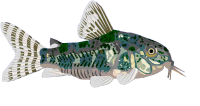Bagarius
Bagarius
Is there an easy way to distinguish between the 3 species? Also I've seen conflicting info on which one gets which size. They are periodically available but I don't want one which gets gigantic. Has anyone kept them, if so what is ideal temp?
- Silurus
- Posts: 12460
- Joined: 31 Dec 2002, 11:35
- I've donated: $12.00!
- My articles: 55
- My images: 896
- My catfish: 1
- My cats species list: 90 (i:0, k:0)
- Spotted: 428
- Location 1: Singapore
- Location 2: Moderator Emeritus
It's fairly easy to tell B. suchus from the other two species by it's much flatter and slightly more elongate body. Bagarius suchus will generally have a series of bumps on the back (which the other two species will not have).
What is not easy is telling the remaining three species (B. bagarius/B. yarrelli/B. rutilus) apart. Bagarius rutilus is only known from northern Vietnam and the Red River drainage in southern China, so it is very unlikely that you will encounter this species. The situation is a lot more complicated with B. bagarius/B. yarrelli. As far as India is concerned (from where these species were originally described), I find no evidence that there are two species. There seems to only one species for which the name B. bagarius should be used (B. yarrelli would then be a junior synonym).
That leaves the smaller Indochinese species that Tyson calls "B. bagarius" (which is different from Indian Bagarius and has not been formally described). This is distinguished from the larger Bagarius by a darker pectoral -fin base and the pelvic fins displaced more forward (in line with the base of the last dorsal-fin ray vs. posterior to in "B. yarrelli"). Admittedly, these are not characters one can easily discern in live fish in an aquarium.
The situation is made much more complicated by the fact that there appear to be several different giant species currently considered "B. yarrelli". It seems that the Southeast Asian populations (for which the name B. lica is available) are different from the Indian ones, and there may be another undescribed species in Myanmar. Again the differences among these large Bagarius are not easily discernible among live fish.
Back to husbandry. Ideal temps would be in the low 70s.
What is not easy is telling the remaining three species (B. bagarius/B. yarrelli/B. rutilus) apart. Bagarius rutilus is only known from northern Vietnam and the Red River drainage in southern China, so it is very unlikely that you will encounter this species. The situation is a lot more complicated with B. bagarius/B. yarrelli. As far as India is concerned (from where these species were originally described), I find no evidence that there are two species. There seems to only one species for which the name B. bagarius should be used (B. yarrelli would then be a junior synonym).
That leaves the smaller Indochinese species that Tyson calls "B. bagarius" (which is different from Indian Bagarius and has not been formally described). This is distinguished from the larger Bagarius by a darker pectoral -fin base and the pelvic fins displaced more forward (in line with the base of the last dorsal-fin ray vs. posterior to in "B. yarrelli"). Admittedly, these are not characters one can easily discern in live fish in an aquarium.
The situation is made much more complicated by the fact that there appear to be several different giant species currently considered "B. yarrelli". It seems that the Southeast Asian populations (for which the name B. lica is available) are different from the Indian ones, and there may be another undescribed species in Myanmar. Again the differences among these large Bagarius are not easily discernible among live fish.
Back to husbandry. Ideal temps would be in the low 70s.

- yellowcat
- Posts: 142
- Joined: 08 Sep 2004, 22:15
- I've donated: $125.00!
- My images: 74
- My cats species list: 39 (i:36, k:16)
- Spotted: 41
- Location 1: Los Angeles
- Location 2: USA
- Interests: auchenoglaninae, pimelodidae, pseudopimelodidae, doradidae
Mini-Goonch
I recently acquired a B. Bagarius last Dec. It arrived at 6" and is now at around 7-1/2". Very interesting fish and so far co-exists well with a variety of other catfish species from Asia, S.A. & Africa. All my fish seem to do well at 74F. This fish seems to display two moods, either still on the bottom or frantic attack mode. I started it out on black worms and shortly after to big earthworms like nightcrawlers which it loves to rip from my hand. It immediately goes into attack mode as soon as it hears me open the tank cover. It doesn't mind light, unlike several of my other species and hangs out in the rocks and wood in the "sunny' end of the tank. It started eating feeder guppies when introduced and has moved on to small feeder goldfish. When I dump in a bag of confused small goldfish it takes advantage and eats 3 or 4 before they disperse. What's cool is it would survive nicely just on big worms if someone wanted one without the disease risk of live feeder fish. The only agressive behaviour it shows toward the other catfish is that it will attempt a quick nip while staying in place if another fish gets too close, like an inch away. Supposedly it's maximum size potential is around 8", time will tell. From what I've seen, you wouldn't to hand feed a B. Yarelli...




